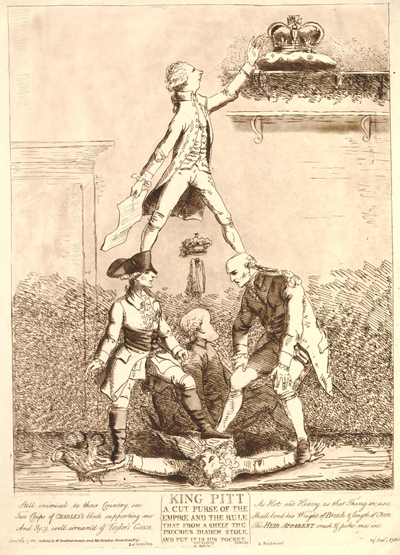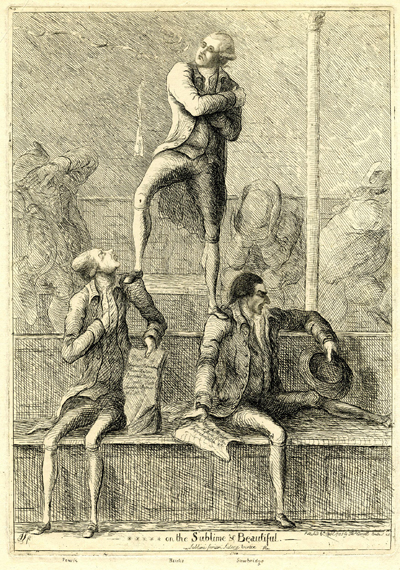King Pitt
This is one of two prints, sometimes attributed to Gillray, using essentially the same image, but with some differences in title and textual elements and some variation in the persons included. The other print is Prince Pitt.

© Trustees of the British Museum
Both prints appeared during the King's madness which began in the summer of 1788 and both suggest that Pitt is like the evil Claudius in Shakespeare's play, who, by murdering Hamlet's father and marrying Hamlet's mother, usurped the crown and prevented the young Hamlet from becoming King.
In a brutal conversation with his mother, Hamlet describes his uncle, King Claudius, as a
cut purse of the empire and the rule that from a shelf the precious diadem stole, and put it in his pocket.
The lines are quoted in both King Pitt and Prince Pitt (though in different places). And as if in illustration of Shakespeare's text, Pitt is shown in the process of stealing "from a shelf the precious diadem" which is the British crown.
In King Pitt, he is aided and abetted by three men: the Duke of Grafton, Baron Sydney, and the Duke of Richmond who stand or sit upon the prostrate Prince of Wales, preventing him from making any response to Pitt's theft. Grafton was a member of Pitt's father's cabinet, a former Prime Minister himself, and, in this case a literal supporter of the younger Pitt as he makes a grab for the crown.
From 1783 to 1789, Sydney was Home Secretary (and Colonial Secretary) under Pitt. As the baron's coronet above his head and between Pitt's legs is intended to remind us, Sydney was raised to the Peerage by Pitt becoming Baron Sydney and Leader of the House of Lords as soon as Pitt became Prime Minister. The strange object beneath the coronet is what was called a tailor's goose a small, thin iron so named because the handle of the iron was like the necks of two geese facing one another. According to the lines at the bottom of the print, Sydney was "well sirnam'd (sic) the Taylor's Goose" no doubt because his jutting forehead looked like the handle of the tailor's goose. Sitting in profile on the Prince, he lends "his Weight of Breech and length of Chin" to crush the Heir Apparent and push Pitt into his place.
The third supporter of Pitt is the Duke of Richmond. Richmond was Master-General of the Ordnance, in Pitt's cabinet. During the debate on the proposed Regency, Richmond was an outspoken supporter of Pitt and an opponent of an unrestricted Regency.
Both Grafton and Richmond could trace their sometimes complicated lineage to the deposed Stuarts ("Still inimical to their Country, see Two Chips of Charles's block supporting [Pitt]" so in addition to seeing Pitt like Claudius, the print suggests that Pitt and his supporters may be part of a much-belated Stuart plot to overthrow the House of Brunswick.
In fact, Pitt did use every tactic at his disposal to prevent or at least delay, the creation of a Regency, or, in the worst case, severely limit it if it had to occur. He knew, as any objective observer did, that the Prince was ill-suited for kingship, being monumentally selfish, dishonest, amd irresponsible. He also knew that a new King or Regent would likely result in a new Ministry headed by the Whig leader, Charles James Fox, and that he (Pitt) would be out of a job.
It was this clearly self-serving motive that suggested to Pitt's enemies that his reason for opposing the Prince and the Regency was less about reaffirming the constitutional authority of Parliament to decide how to proceed while the present Monarch was still alive (though tenporarily incapacitated) and more about maintaining and even expanding his power and control.
But there no evidence for the hyperbolic charges brought forth in this print. Indeed, Pitt's resolutions, though certainly gaining him additional time in office, were hardly threatening. According to London Times, December 19, 1788, Pg. 3, they consisted of 1) Acknowledging that the King was temporarily indisposed and that "the personal exercise of the Royal Authority" was "for the present interrupted." 2) That it was the "Right and Duty" of the Lords and Commons,"to provide the means of supplying the deficit of the personal excrcise of the Royal Authority." And 3) that the Lords and Commons
should determine on the means whereby the Royal Assent may be given in Parliament to such Bills as may be passed by the two Houses of Parliament, respecting the excrcise of the powers and authorities of the Crown, in the name, and on the behalf ot the King, during the continuance of his Majesty's present indisposition.
In King Pitt, the paper in Pitt's right hand, while he reaches for the crown, refers to "Dornford's Address," which one might suppose, would contain treasonous expressions appropriate to Pitt's action. But, as reported in the London Chronicle on December 18, 1788, Dornford's words are a tame reiteration of Pitt's resolutions.
Mr. Dornford moved that the Thanks of the Court be given to the Right Hon. William Pitt, Chancellor of the Exchequer, and the other Members of Parliament, who had supported the right of the Lords and Commons to provide a remedy to supply the defect in the exercise of the executive power by his Majesty's indisposition.
King Pitt was jointly published by Hannah Humphrey and Thomas Bradshaw. And it is perhaps because the Humphreys were involved that some people, including Draper Hill, seem to think that the print could be by Gillray. But it is clear that Bradshaw was the primary publisher. Thomas Bradshaw consistently opposed Pitt's treatment of the Prince in prints like The Free Regency and The Restricted Regency, and on King Pitt Hannah's name is misspelled ("Miss Humphrys"), so it is questionable how much the Humphreys were really involved.
Stylistically (to me, at least) the print is cruder and less polished than most of Gillray's prints in 1788/89. It does NOT look like a Gillray. By 1788, even when he was in a hurry, Gillray was creating beautifully realized prints with a perfectly naturalistic sense of gesture, expression, and depth like Blood & Co, Setting Fire to the Tower. . . and The Butchers of Freedom. By contrast King Pitt looks flat and somewhat awkward. The unnecessary and unexplained shading across most of the lower third of King Pitt created using squiggly lines is more characteristic of James Sayers than it is of Gillray. And the basic design of the print with Pitt standing upon the shouders of Grafton and Richmond is almost certainly influenced by Sayers' ***** on the Sublime & Beautiful published in 1785

***** on the Sublime & Beautiful
[April 6, 1785]
© Trustees of the British Museum
Sources and Reading
- Commentary from the British Museum on King Pitt.
- "William Pitt the Younger," Wikipedia
- "Augustus FitzRoy, 3rd Duke of Grafton," Wikipedia
- "Charles Lennox, 3rd Duke of Richmond," Wikiwand
- "Thomas Townshend, 1st Viscount Sydney," Wikipedia
- "George IV," Wikipedia
Comments & Corrections
NOTE: Comments and/or corrections are always appreciated. To make that easier, I have included a form below that you can use. I promise never to share any of the info provided without your express permission.